remote control BMW X5 2004 E53 Central Body Electronics Workshop Manual
[x] Cancel search | Manufacturer: BMW, Model Year: 2004, Model line: X5, Model: BMW X5 2004 E53Pages: 64, PDF Size: 4.03 MB
Page 14 of 64
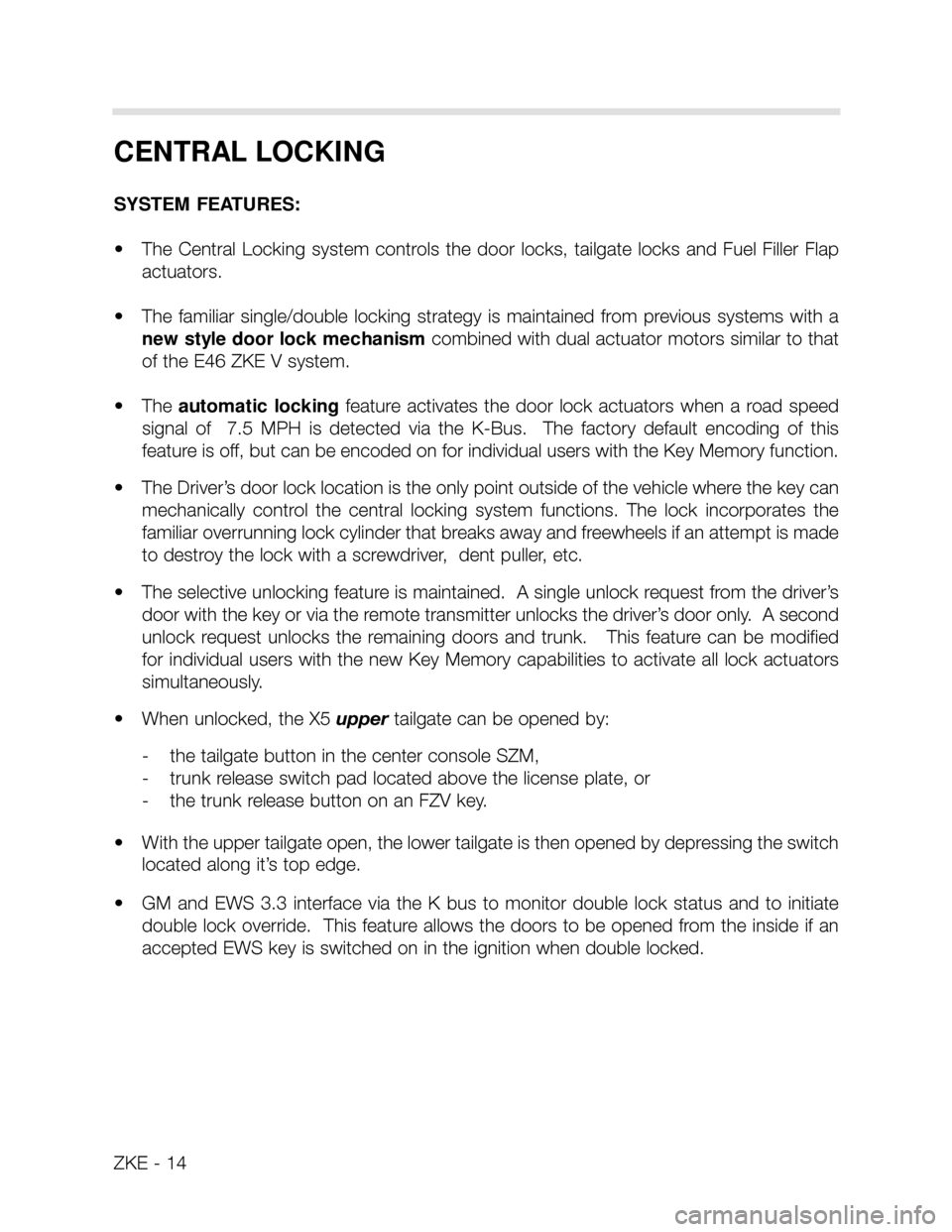
ZKE - 14
CENTRAL LOCKING
SYSTEM FEATURES:
• The Central Locking system controls the door locks, tailgate locks and Fuel Filler Flap
actuators.
• The familiar single/double locking strategy is maintained from previous systems with a
new style door lock mechanismcombined with dual actuator motors similar to that
of the E46 ZKE V system.
• The automatic locking feature activates the door lock actuators when a road speed
signal of 7.5 MPH is detected via the K-Bus. The factory default encoding of this
feature is off, but can be encoded on for individual users with the Key Memory function.
• The Driver’s door lock location is the only point outside of the vehicle where the key can
mechanically control the central locking system functions. The lock incorporates the
familiar overrunning lock cylinder that breaks away and freewheels if an attempt is made
to destroy the lock with a screwdriver, dent puller, etc.
• The selective unlocking feature is maintained. A single unlock request from the driver’s
door with the key or via the remote transmitter unlocks the driver’s door only. A second
unlock request unlocks the remaining doors and trunk. This feature can be modified
for individual users with the new Key Memory capabilities to activate all lock actuators
simultaneously.
• When unlocked, the X5 uppertailgate can be opened by:
- the tailgate button in the center console SZM,
- trunk release switch pad located above the license plate, or
- the trunk release button on an FZV key.
• With the upper tailgate open, the lower tailgate is then opened by depressing the switch
located along it’s top edge.
• GM and EWS 3.3 interface via the K bus to monitor double lock status and to initiate
double lock override. This feature allows the doors to be opened from the inside if an
accepted EWS key is switched on in the ignition when double locked.
Page 18 of 64
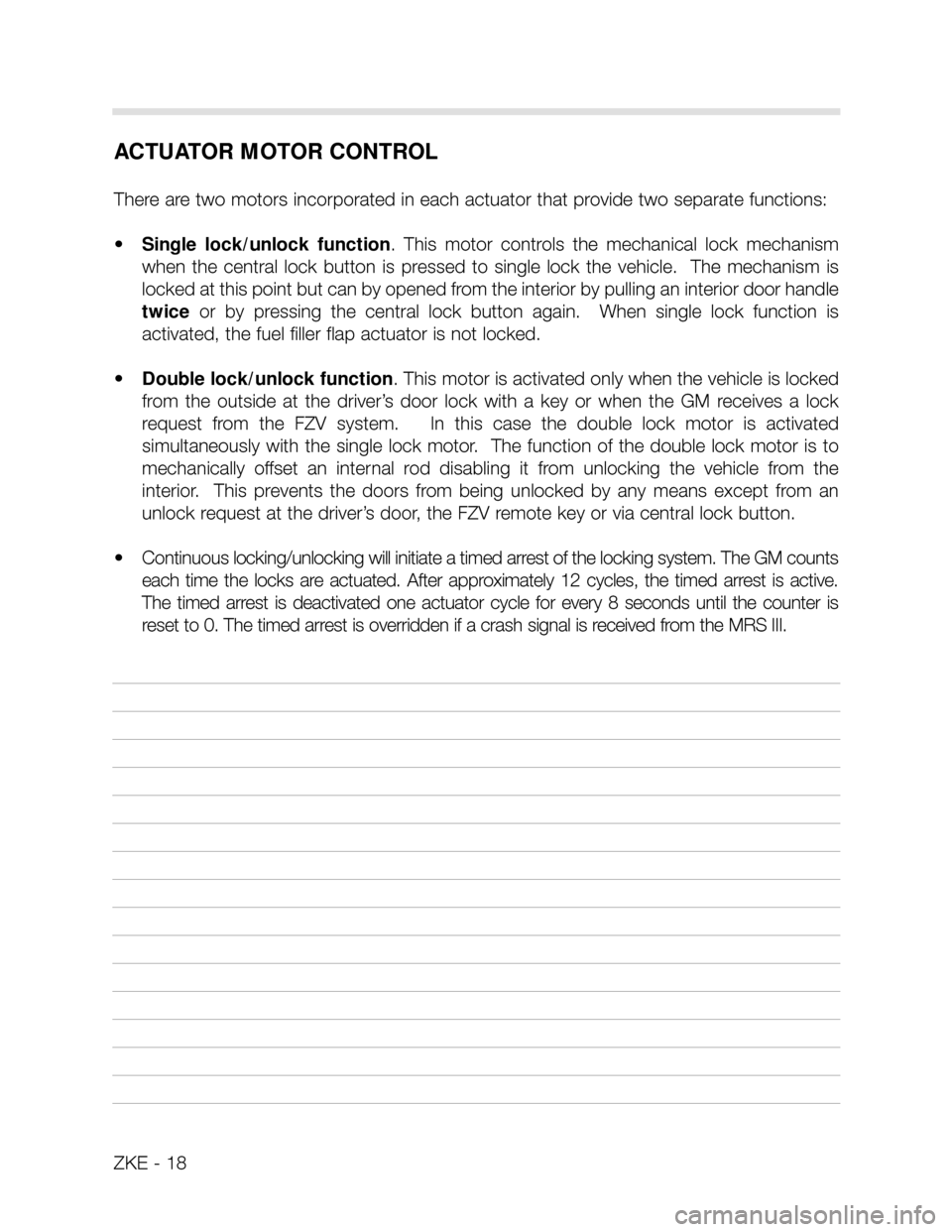
ZKE - 18
ACTUATOR MOTOR CONTROL
There are two motors incorporated in each actuator that provide two separate functions:
•Single lock/unlock function. This motor controls the mechanical lock mechanism
when the central lock button is pressed to single lock the vehicle. The mechanism is
locked at this point but can by opened from the interior by pulling an interior door handle
twice or by pressing the central lock button again. When single lock function is
activated, the fuel filler flap actuator is not locked.
•Double lock/unlock function. This motor is activated only when the vehicle is locked
from the outside at the driver’s door lock with a key or when the GM receives a lock
request from the FZV system. In this case the double lock motor is activated
simultaneously with the single lock motor. The function of the double lock motor is to
mechanically offset an internal rod disabling it from unlocking the vehicle from the
interior. This prevents the doors from being unlocked by any means except from an
unlock request at the driver’s door, the FZV remote key or via central lock button.
• Continuous locking/unlocking will initiate a timed arrest of the locking system. The GM counts
each time the locks are actuated. After approximately 12 cycles, the timed arrest is active.
The timed arrest is deactivated one actuator cycle for every 8 seconds until the counter is
reset to 0. The timed arrest is overridden if a crash signal is received from the MRS III.
Page 20 of 64
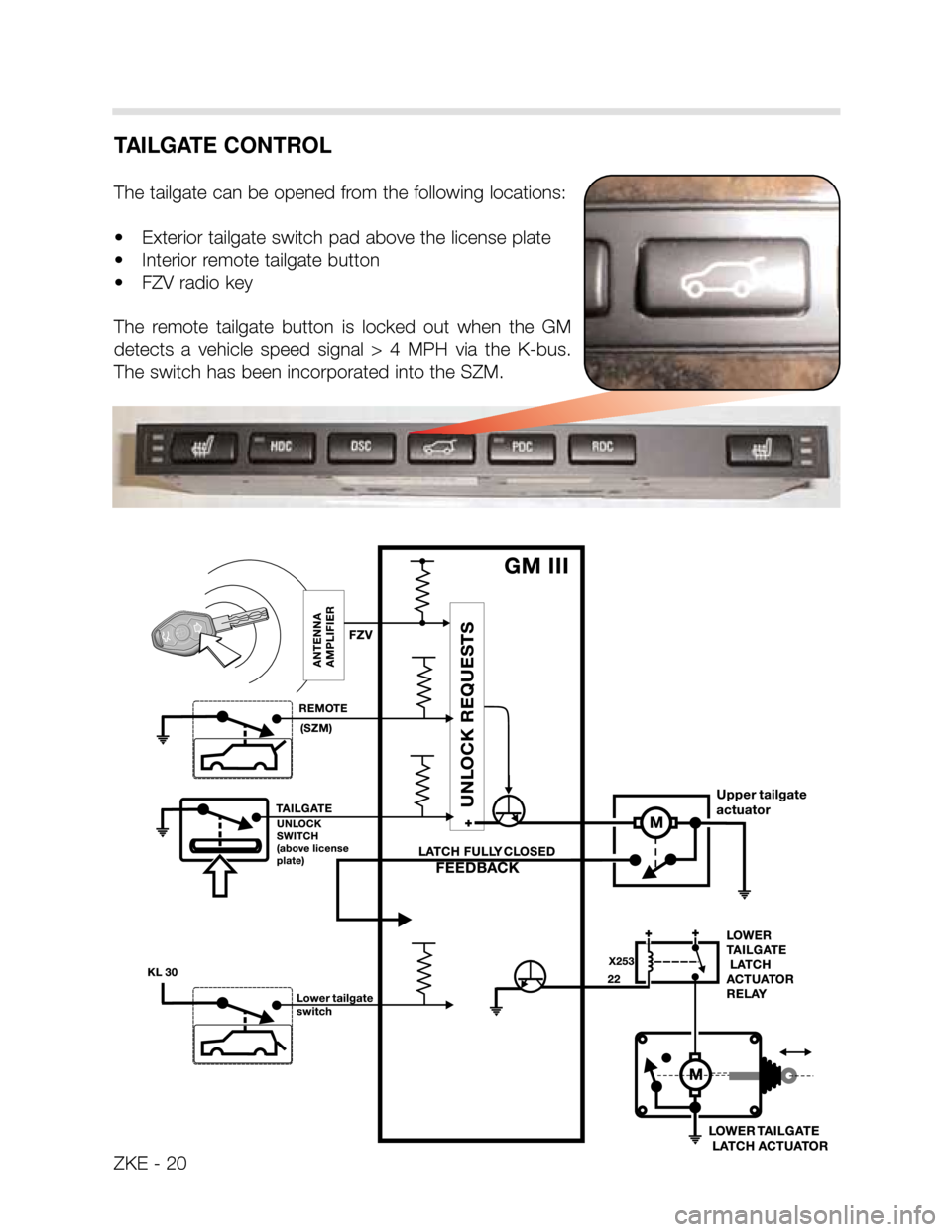
TAILGATE CONTROL
The tailgate can be opened from the following locations:
• Exterior tailgate switch pad above the license plate
• Interior remote tailgate button
• FZV radio key
The remote tailgate button is locked out when the GM
detects a vehicle speed signal > 4 MPH via the K-bus.
The switch has been incorporated into the SZM.
ZKE - 20
Page 24 of 64
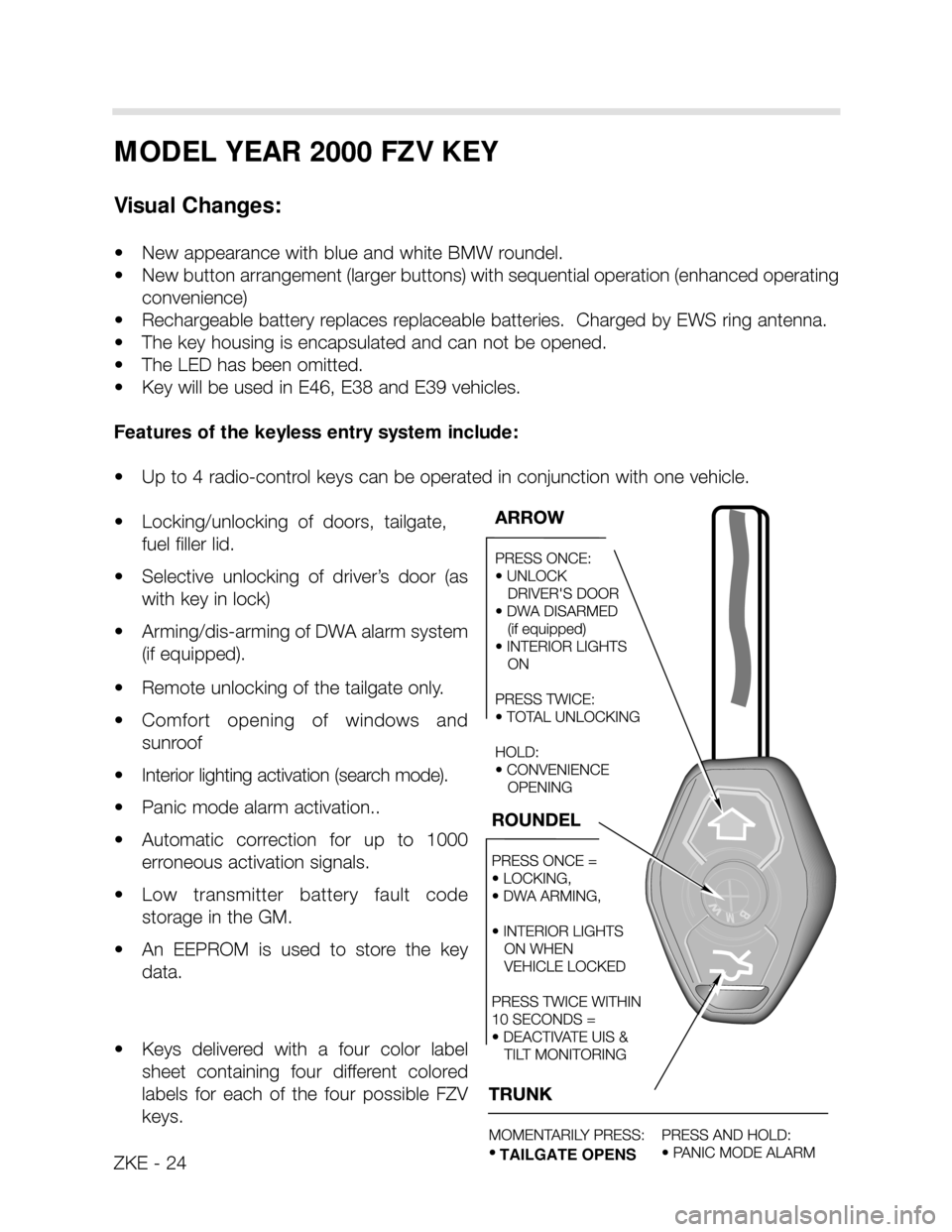
MODEL YEAR 2000 FZV KEY
Visual Changes:
• New appearance with blue and white BMW roundel.
• New button arrangement (larger buttons) with sequential operation (enhanced operating
convenience)
• Rechargeable battery replaces replaceable batteries. Charged by EWS ring antenna.
• The key housing is encapsulated and can not be opened.
• The LED has been omitted.
• Key will be used in E46, E38 and E39 vehicles.
Features of the keyless entry system include:
• Up to 4 radio-control keys can be operated in conjunction with one vehicle.
• Locking/unlocking of doors, tailgate,
fuel filler lid.
• Selective unlocking of driver’s door (as
with key in lock)
• Arming/dis-arming of DWA alarm system
(if equipped).
• Remote unlocking of the tailgate only.
• Comfort opening of windows and
sunroof
• Interior lighting activation (search mode).
• Panic mode alarm activation..
• Automatic correction for up to 1000
erroneous activation signals.
• Low transmitter battery fault code
storage in the GM.
• An EEPROM is used to store the key
data.
• Keys delivered with a four color label
sheet containing four different colored
labels for each of the four possible FZV
keys.
ZKE - 24TAILGATE OPENS
Page 26 of 64
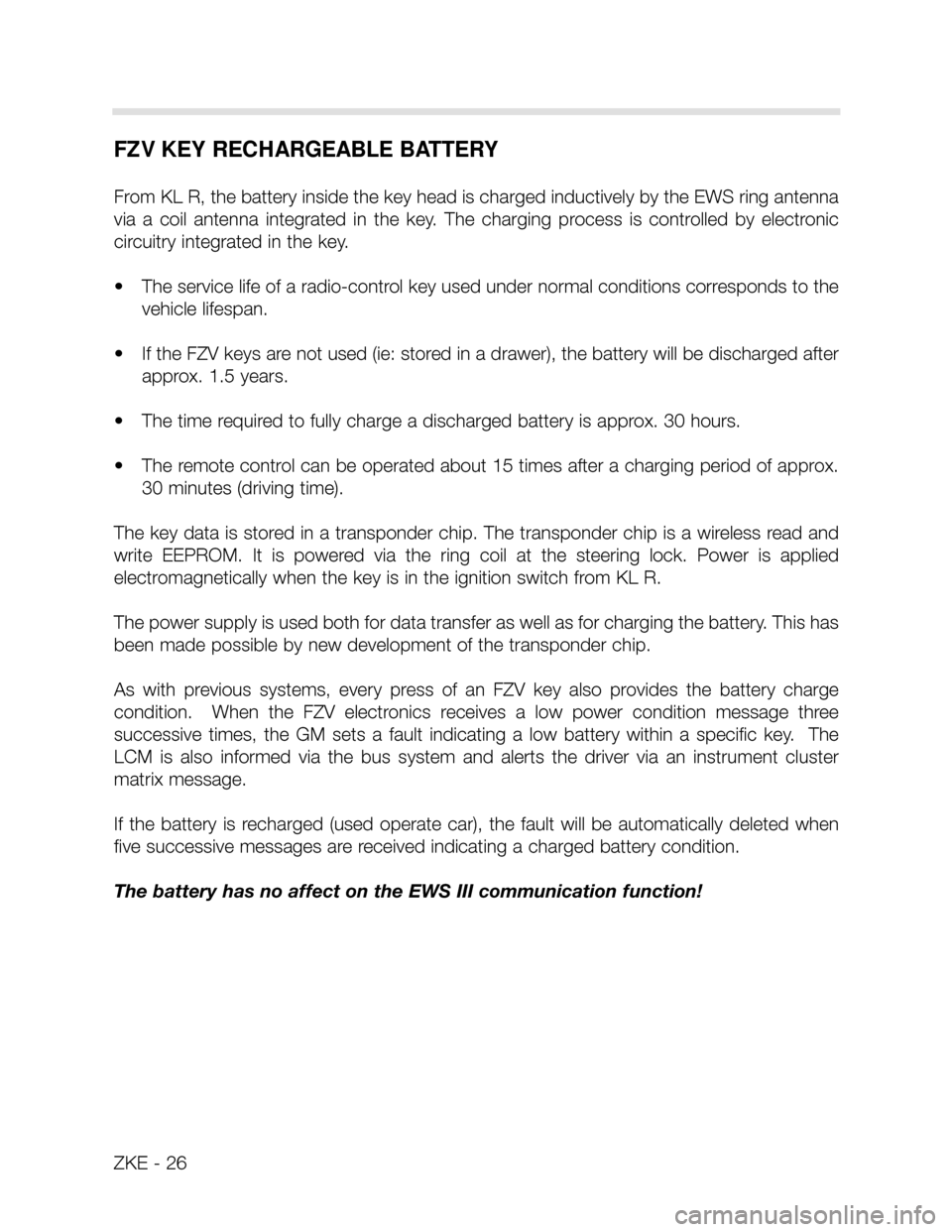
FZV KEY RECHARGEABLE BATTERY
From KL R, the battery inside the key head is charged inductively by the EWS ring antenna
via a coil antenna integrated in the key. The charging process is controlled by electronic
circuitry integrated in the key.
• The service life of a radio-control key used under normal conditions corresponds to the
vehicle lifespan.
• If the FZV keys are not used (ie: stored in a drawer), the battery will be discharged after
approx. 1.5 years.
• The time required to fully charge a discharged battery is approx. 30 hours.
• The remote control can be operated about 15 times after a charging period of approx.
30 minutes (driving time).
The key data is stored in a transponder chip. The transponder chip is a wireless read and
write EEPROM. It is powered via the ring coil at the steering lock. Power is applied
electromagnetically when the key is in the ignition switch from KL R.
The power supply is used both for data transfer as well as for charging the battery. This has
been made possible by new development of the transponder chip.
As with previous systems, every press of an FZV key also provides the battery charge
condition. When the FZV electronics receives a low power condition message three
successive times, the GM sets a fault indicating a low battery within a specific key. The
LCM is also informed via the bus system and alerts the driver via an instrument cluster
matrix message.
If the battery is recharged (used operate car), the fault will be automatically deleted when
five successive messages are received indicating a charged battery condition.
The battery has no affect on the EWS III communication function!
ZKE - 26
Page 28 of 64
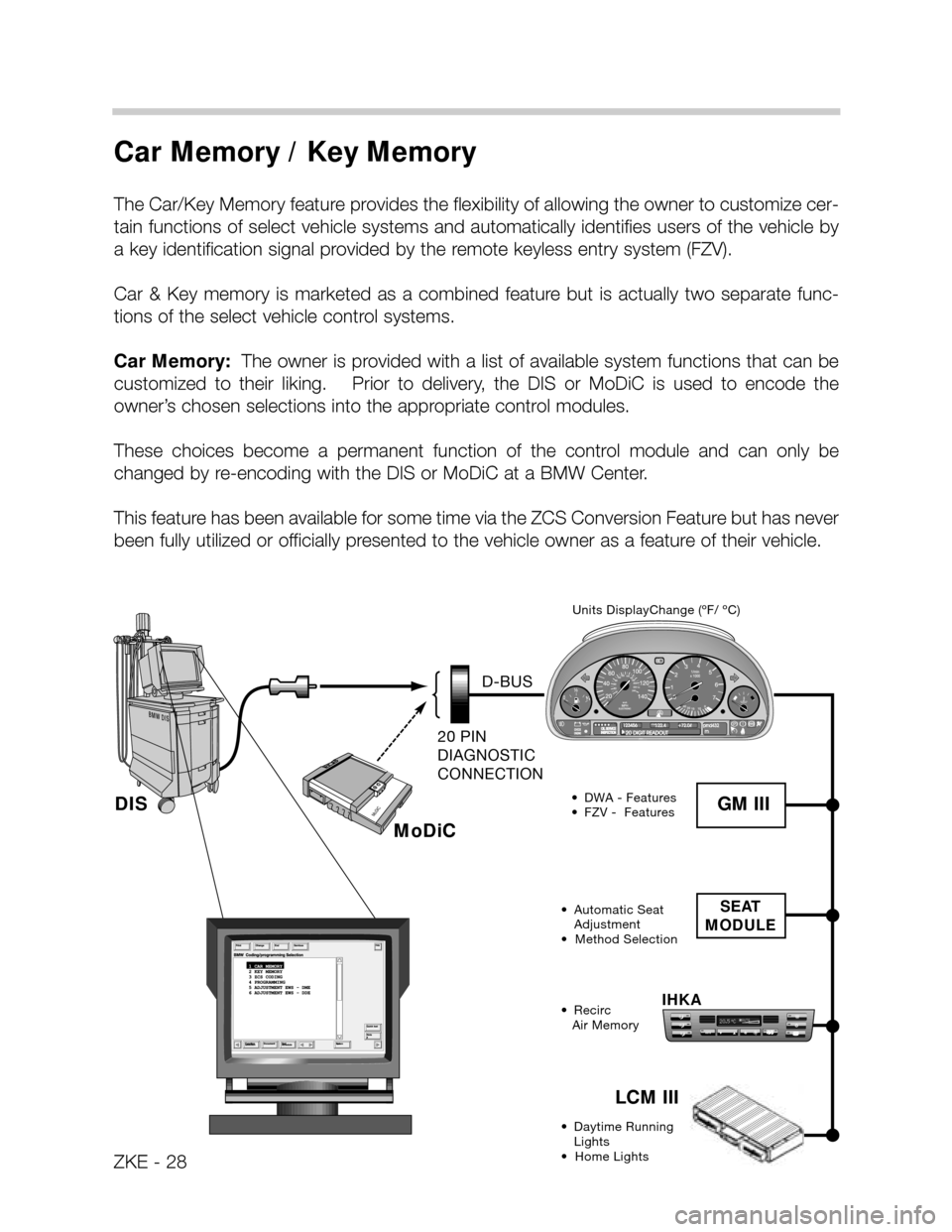
Car Memory / Key Memory
The Car/Key Memory feature provides the flexibility of allowing the owner to customize cer-
tain functions of select vehicle systems and automatically identifies users of the vehicle by
a key identification signal provided by the remote keyless entry system (FZV).
Car & Key memory is marketed as a combined feature but is actually two separate func-
tions of the select vehicle control systems.
Car Memory: The owner is provided with a list of available system functions that can be
customized to their liking. Prior to delivery, the DIS or MoDiC is used to encode the
owner’s chosen selections into the appropriate control modules.
These choices become a permanent function of the control module and can only be
changed by re-encoding with the DIS or MoDiC at a BMW Center.
This feature has been available for some time via the ZCS Conversion Feature but has never
been fully utilized or officially presented to the vehicle owner as a feature of their vehicle.
Units DisplayChange (ºF/ ºC)
• DWA - Features
• FZV - Features
• Automatic Seat
Adjustment
• Method Selection
• Recirc
Air Memory
• Daytime Running
Lights
• Home Lights
UNLEADED GASOLINE ONLY01
220km/hMPH1/min
x1000
40 6080100120
140
160
180
200
220
240
1
023
4
5
6
75030
20
15
1220 406080
100
120
1401
1
MoDiC
20 PIN
DIAGNOSTIC
CONNECTION
MoDiC
D-BUS
DIS
A
SEAT
MODULE
GMV
IHKA
LSZ
ZKE - 28
LCM III
GM III
Page 37 of 64
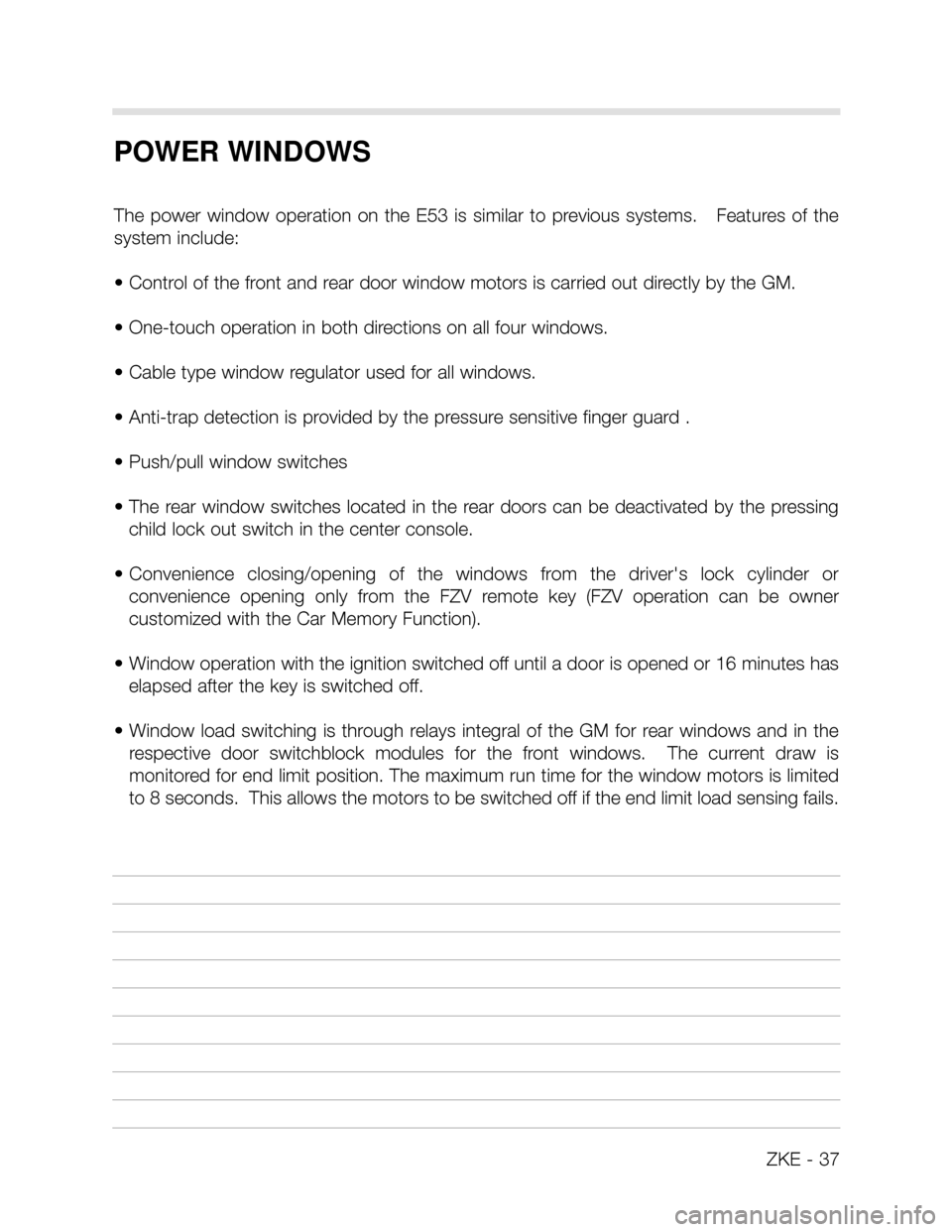
ZKE - 37
POWER WINDOWS
The power window operation on the E53 is similar to previous systems. Features of the
system include:
• Control of the front and rear door window motors is carried out directly by the GM.
• One-touch operation in both directions on all four windows.
• Cable type window regulator used for all windows.
• Anti-trap detection is provided by the pressure sensitive finger guard .
• Push/pull window switches
• The rear window switches located in the rear doors can be deactivated by the pressing
child lock out switch in the center console.
• Convenience closing/opening of the windows from the driver's lock cylinder or
convenience opening only from the FZV remote key (FZV operation can be owner
customized with the Car Memory Function).
• Window operation with the ignition switched off until a door is opened or 16 minutes has
elapsed after the key is switched off.
• Window load switching is through relays integral of the GM for rear windows and in the
respective door switchblock modules for the front windows. The current draw is
monitored for end limit position. The maximum run time for the window motors is limited
to 8 seconds. This allows the motors to be switched off if the end limit load sensing fails.
Page 54 of 64
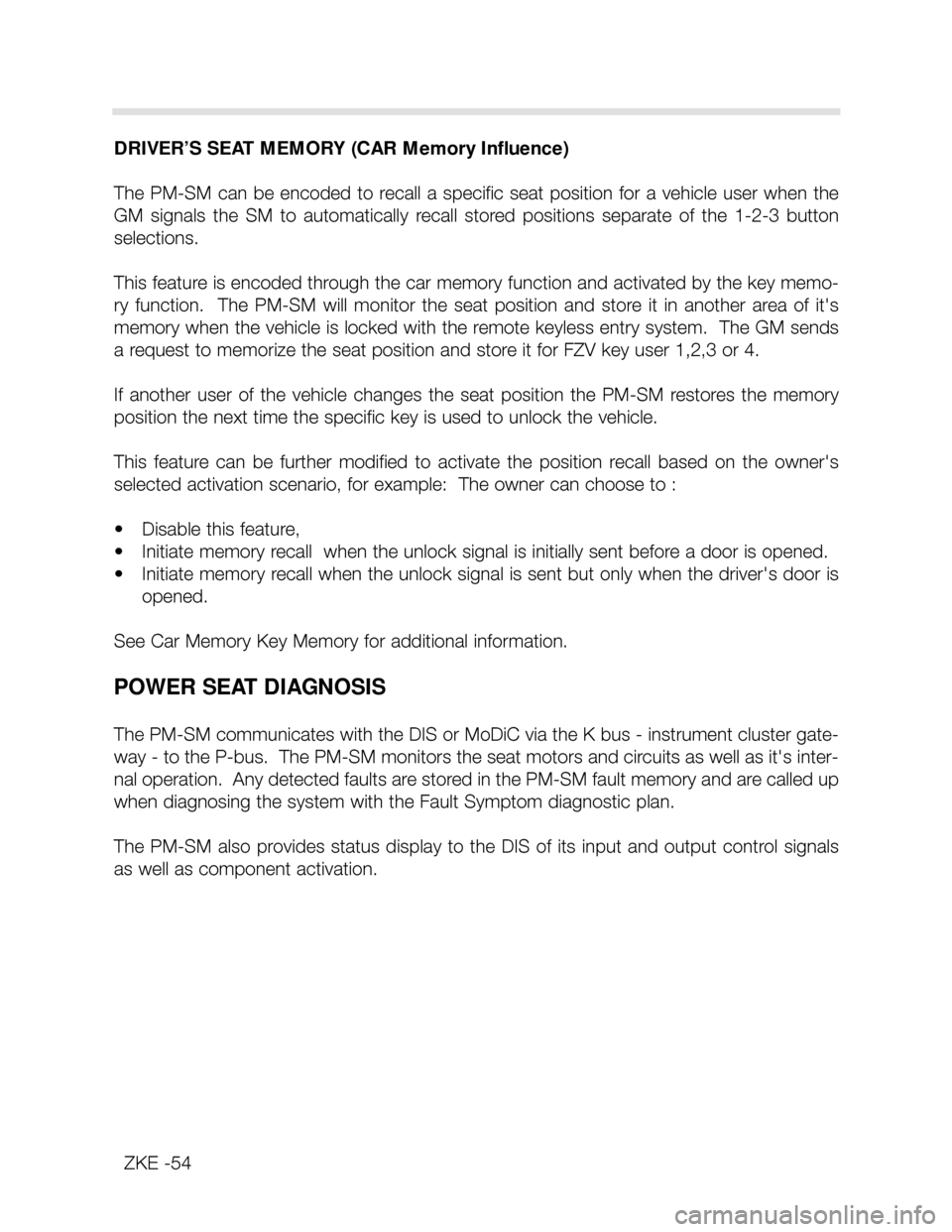
ZKE -54
DRIVER’S SEAT MEMORY (CAR Memory Influence)
The PM-SM can be encoded to recall a specific seat position for a vehicle user when the
GM signals the SM to automatically recall stored positions separate of the 1-2-3 button
selections.
This feature is encoded through the car memory function and activated by the key memo-
ry function. The PM-SM will monitor the seat position and store it in another area of it's
memory when the vehicle is locked with the remote keyless entry system. The GM sends
a request to memorize the seat position and store it for FZV key user 1,2,3 or 4.
If another user of the vehicle changes the seat position the PM-SM restores the memory
position the next time the specific key is used to unlock the vehicle.
This feature can be further modified to activate the position recall based on the owner's
selected activation scenario, for example: The owner can choose to :
• Disable this feature,
• Initiate memory recall when the unlock signal is initially sent before a door is opened.
• Initiate memory recall when the unlock signal is sent but only when the driver's door is
opened.
See Car Memory Key Memory for additional information.
POWER SEAT DIAGNOSIS
The PM-SM communicates with the DIS or MoDiC via the K bus - instrument cluster gate-
way - to the P-bus. The PM-SM monitors the seat motors and circuits as well as it's inter-
nal operation. Any detected faults are stored in the PM-SM fault memory and are called up
when diagnosing the system with the Fault Symptom diagnostic plan.
The PM-SM also provides status display to the DIS of its input and output control signals
as well as component activation.